Rail Asset Management Market Insights:
The global rail asset management market was valued at USD 10 billion in 2021 and is projected to reach USD 17.5 billion by 2031, growing at a CAGR of 5.8% from 2022 to 2031.
The goal of rail asset management is to maximize asset availability at the lowest possible cost and risk over the course of the asset's entire life. Rail asset management solutions help in utilizing sophisticated software to gather and analyze use relevant data for predictive and preventive maintenance rather than response maintenance solutions. Achieving the best lifecycle value and guaranteeing passenger safety depend on such visibility. For railway public transport and maintenance establishments are upholding full visibility into the state of their capital assets throughout the railway asset lifecycle.
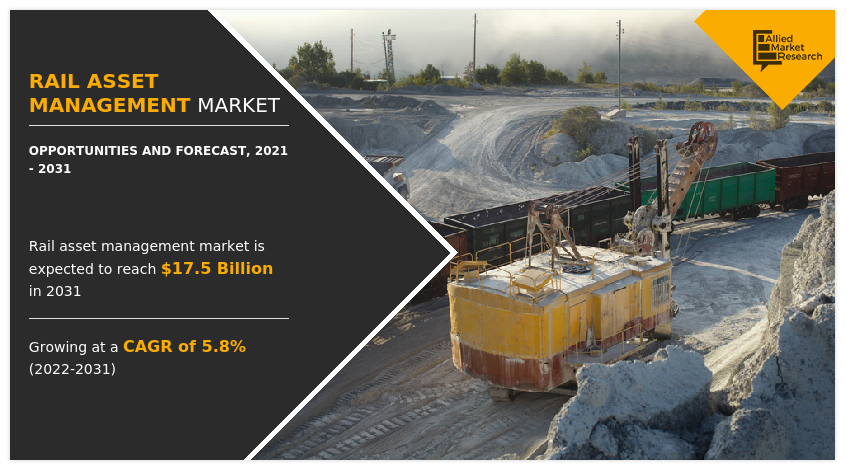
Currently, digitalization is changing traditional railway asset management systems, allowing rail organizations to gather, preserve, and modify crucial asset data and provide enormous monetary advantages. According to the rail supply digitization report, 2021, 92% of rail industry companies aim to invest in digitization their business during the forecast period. The rail asset management market is segmented into Offering, Deployment and Application Area.
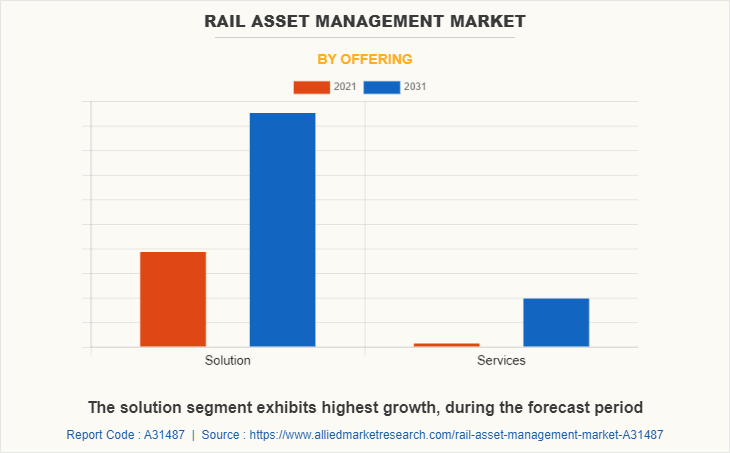
Rail asset management solutions are electronics, software, and advising components within asset management. These rail systems use the most detection and monitoring technology, customised software, and wireless connections to promptly and precisely collect data required for managing rail transport assets or maintaining and building railway system. These solutions include asset performance management, analytics, asset planning & scheduling, security, and workforce management. Therefore, rail asset management solutions assist proper freight management for various railway lines help government and private railway organization to function seamlessly.
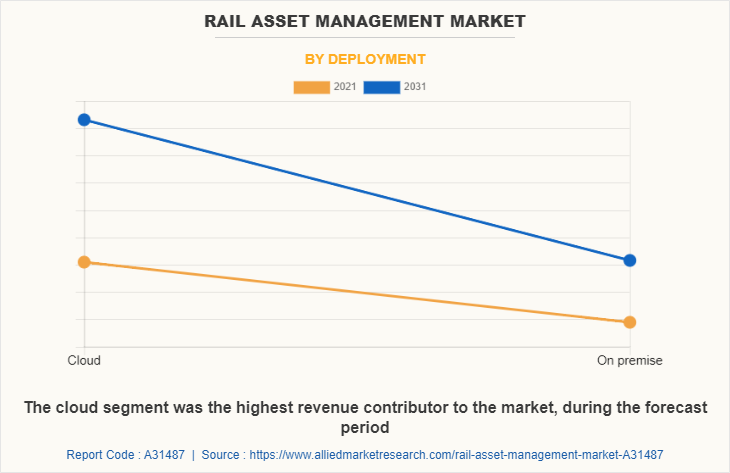
A form of rail asset management known as the cloud involves outsourcing computing needs of companies to a third party. Since there is no need to invest in infrastructure or technology, advantages include improved mobility, increased efficiency, and lower prices. Furthermore, increase in prevalence for cloud-based solutions provide lucrative opportunities for the rail asset management industry.
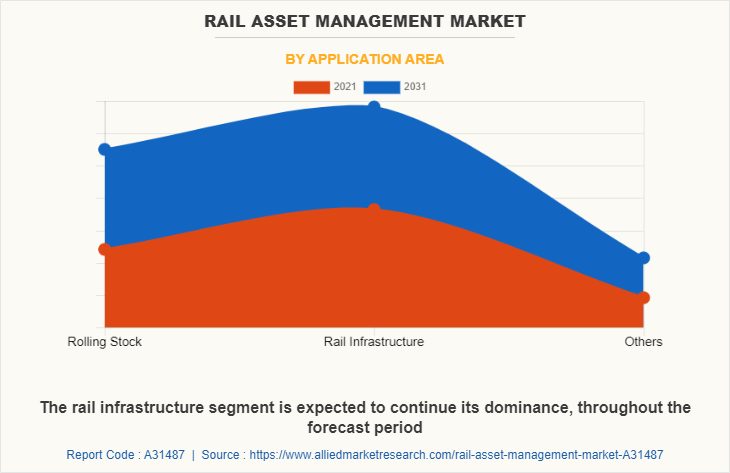
In the rail transportation sector, rolling stock refers to both powered and non-powered railway vehicles, such as locomotives, freight and passenger cars (or coaches), and non-revenue carriages. Rail asset management is employed in rolling stock to maintain and improve rail assets. Moreover, to conduct effective operations, reduce costs, enhance operational efficiency, and improve safety at rail facilities, rail asset management can be done using on-site methods or using cloud computing. Each locomotive can be monitored for efficiency, condition, dependability, and safety during all phases of operations (production, transportation, and others). In addition, the rail asset management market growth is predicted to deliver sophisticated freight management with the help of rolling stock application.
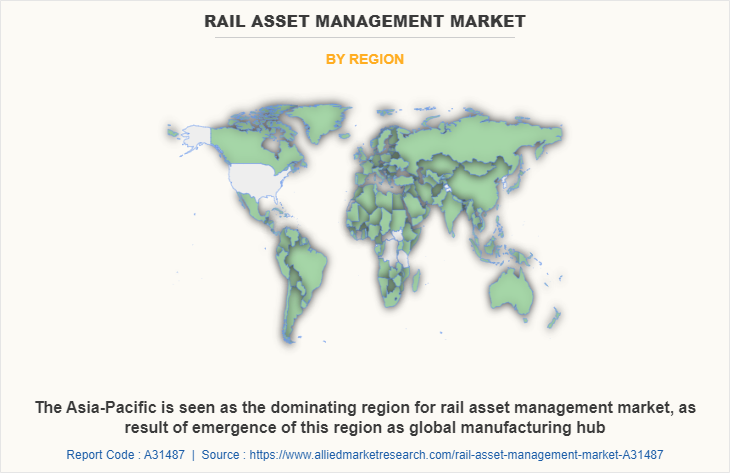
Region wise, the rail asset management market trends are analyzed across North America (the U.S. and Canada), Europe (the UK, Germany, France, Italy, Spain, the Netherlands, and Rest of Europe), Asia-Pacific (China, Japan, India, Australia, South Korea, and Rest of Asia-Pacific), and LAMEA (Latin America, the Middle East, and Africa).
Presence of several costumers in countries like China, Japan, Singapore, and South Korea is anticipated to propel growth of the market in Asia-Pacific. The market share of the railway management system in this region is also growing as a result of rise in disposable income in the region, growth in urbanization, and rise in population. Implementation of advanced technology, growth of the tourism industry, and acceptance of high-tech advances has led to growth.
Top Impacting Factors:
Significant factors that impact the growth of the global rail asset management market share include rapid urbanization, rising adoption of digitalization along with dependency on artificial intelligence (AI). Growth in demand for effective railroad operations has positively impacted the market’s growth. However, high initial cost of integration and deployment, hampers the growth of this market. On the contrary, surge in government initiative to invest in railroad management systems have provide potential rise in prevalence for cloud-based railway management solutions that is expected to provide lucrative market opportunity during the forecast period.
Competition Analysis:
Competitive analysis and profiles of the major rail asset management industry, such as Accenture plc, Alstom SA, Capgemini SE, Cisco Systems, Inc., Hitachi, Ltd., Huawei Technologies Co., Ltd., International Business Machines Corporation (IBM), L&T Technology Services Limited (LTTS), SAP SE and Siemens AG are provided in this report.
Key Benefits for Stakeholders:
- This study comprises analytical depiction of the rail asset management market size along with the current trends and future estimations to depict the imminent investment pockets.
- The overall rail asset management market analysis is determined to understand the profitable trends to gain a stronger foothold.
- The report presents information related to key drivers, restraints, and opportunities with a detailed impact analysis.
- The current rail asset management market forecast is quantitatively analyzed from 2021 to 2031 to benchmark the financial competency.
- Porter’s five forces analysis illustrates the potency of the buyers and suppliers in the smart display.
- The report includes the market share of key vendors and rail asset management market trends.
Rail Asset Management Market Report Highlights
| Aspects | Details |
| Market Size By 2031 | USD 17.5 billion |
| Growth Rate | CAGR of 5.8% |
| Forecast period | 2021 - 2031 |
| Report Pages | 235 |
| By Offering |
|
| By Deployment |
|
| By Application Area |
|
| By Region |
|
| Key Market Players | L&T Technology Services Limited (LTTS), Alstom SA, Huawei Technologies Co., Ltd., Capgemini SE, Siemens AG, International Business Machines Corporation (IBM), Hitachi, Ltd., SAP SE, Accenture plc, Cisco Systems, Inc. |
Analyst Review
Rail asset management entails the maintenance, planning, and effective delivery of a sophisticated rail asset management market. Smart technology solutions have the potential to provide railway operators of rail assets with the information and required to manage all of their rail assets.
Global rail asset management market is highly competitive, owing to strong presence of existing vendors. Rail asset management vendors, who have access to extensive technical and financial resources are anticipated to gain a competitive edge over their rivals, as they have the capacity to cater to the market requirements. The competitive environment in this market is expected to further intensify with increase in technological innovations, product extensions, and different strategies adopted by key vendors.
Rise in demand for sustainable railroad operations is anticipated to propel the rail asset management market share during the forecast period. The industry has expanded as a result of increased acceptance of digitalization and artificial intelligence (AI), as well as government investments in railroad infrastructure. However, the primary challenges limiting market growth are the high initial cost of installation and maintenance. On the other hand, increased reliance on cloud-based railroad management systems is anticipated to increase market penetration, which will fuel the expansion of the rail asset management market during forecast period.
Among the analyzed regions, Europe exhibits highest adoption rate of rail asset management and has been experiencing massive expansion of the market. On the other hand, North America and Asia-PACIFIC is expected to grow at a faster pace, predicting lucrative growth, owing to emerging countries, such as U.S., Japan, Singapore, South Korea, China and India investing in these technologies. Regions, such as the LAMEA, are also expected to offer new opportunities for the Rail asset management market in future.
The key players profiled in the report include Accenture plc, Alstom SA, Capgemini SE, Cisco Systems, Inc., Hitachi, Ltd., Huawei Technologies Co., Ltd., International Business Machines Corporation (IBM), L&T Technology Services Limited (LTTS), SAP SE and Siemens AG. For instance, in February 2020, Alstom purchased Bombardier Transportation. Alstom's rolling stock portfolio would be increased with this acquisition, and the company gained valuable assets for its services division, such as access to a vast network of maintenance facilities and a large number of operational locomotives operative systems. Such initiatives by key players have fuelled the growth of rail asset management market.
Rapid digitalization, adoption of artificial intelligence, and cloud computing solutions are the upcoming trends in the rail asset management market.
Rolling stock and rail infrastructure are considered the leading application of the rail asset management market.
Europe is the largest regional market for rail asset management.
$9,968.0 million is the estimated industry size of rail asset management.
Accenture plc, Alstom SA, SAP SE, Hitachi, Ltd., and International Business Machines Corporation (IBM) are the top companies to hold the market share in rail asset management.
Loading Table Of Content...



